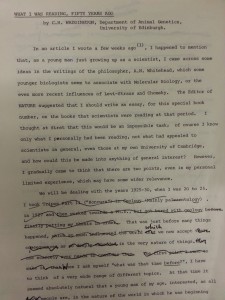 I have recently been reading about the ‘What Scientists Read’ project, which aims to explore the influence of literature and the arts upon scientific thought and practice. The project has interviewed scientists across the Scottish Central Belt with a view to establishing what their literary predilections and influences are, analysing the different genres discussed and their impact upon scientific work. This project reminded me of a draft of an article in our archived papers of Conrad Hal Waddington, the developmental biologist, embryologist and geneticist who was Director of the Institute of Animal Genetics, Edinburgh and Buchanan Professor of Genetics at the University of Edinburgh from 1947-1975. The article, titled ‘What I Was Reading, Fifty Years Ago’, was published under the title ‘Fifty Years On’ in Nature (Volume 258, Issue 5530, pp. 20-21) in November 1975, two months after Waddington’s early death. The draft typescript, marked with Waddington’s annotations and crossings-out, outlines some of his main literary influences during the years 1925-30 when Waddington was aged 20-25. This was at a time before seminal works by T.S. Eliot and Ezra Pound changed the face of modern poetry, so Waddington at this time favoured ‘the English poets of the generation of Wilfrid Owen.’ He also had a keen interest in philosophy. From an early age, Waddington was heavily influenced by the philosopher A.N. Whitehead, lamenting that Whitehead ‘scarcely gets mentioned’, except in the context of being Bertrand Russell’s co-author of Principia Mathematica. Whitehead’s influence on Waddington strongly influenced his way of looking at the world, particularly his opposition to a division between mind and matter. Waddington felt that Whitehead ‘inoculated’ him against ‘the present epidemic intellectual disease, which causes people to argue that the reality of anything is proportional to the precision with which it can be defined in molecular or atomic terms.’
I have recently been reading about the ‘What Scientists Read’ project, which aims to explore the influence of literature and the arts upon scientific thought and practice. The project has interviewed scientists across the Scottish Central Belt with a view to establishing what their literary predilections and influences are, analysing the different genres discussed and their impact upon scientific work. This project reminded me of a draft of an article in our archived papers of Conrad Hal Waddington, the developmental biologist, embryologist and geneticist who was Director of the Institute of Animal Genetics, Edinburgh and Buchanan Professor of Genetics at the University of Edinburgh from 1947-1975. The article, titled ‘What I Was Reading, Fifty Years Ago’, was published under the title ‘Fifty Years On’ in Nature (Volume 258, Issue 5530, pp. 20-21) in November 1975, two months after Waddington’s early death. The draft typescript, marked with Waddington’s annotations and crossings-out, outlines some of his main literary influences during the years 1925-30 when Waddington was aged 20-25. This was at a time before seminal works by T.S. Eliot and Ezra Pound changed the face of modern poetry, so Waddington at this time favoured ‘the English poets of the generation of Wilfrid Owen.’ He also had a keen interest in philosophy. From an early age, Waddington was heavily influenced by the philosopher A.N. Whitehead, lamenting that Whitehead ‘scarcely gets mentioned’, except in the context of being Bertrand Russell’s co-author of Principia Mathematica. Whitehead’s influence on Waddington strongly influenced his way of looking at the world, particularly his opposition to a division between mind and matter. Waddington felt that Whitehead ‘inoculated’ him against ‘the present epidemic intellectual disease, which causes people to argue that the reality of anything is proportional to the precision with which it can be defined in molecular or atomic terms.’
Waddington was also intrigued by thinkers who ‘brought literary criticism and philosophy very near together’, such as I.A. Richards and C.K. Ogden. ‘I doubt’, Waddington muses, ‘if, today, you would find anywhere the intimate interplay between poetry, philosophy and the foundations of science, which Ogden and Richards displayed.’ Waddington’s admiration for this interplay mirrored his own wide-ranging interests. From folk dance and music to art, architecture, ecology, computer science, robotics and more, science for Waddington was always closely integrated within, and informed by, all aspects of man’s life in society and upon earth. What comes across throughout the article is Waddington’s feeling that the flexibility of his interests was partly a product of his time: ‘[i]t was absolutely natural to have interests in philosophy, poetry, even painting, and to allow them to show. This was well before there was considered to be any firm dividing line between the natural or the moral sciences, or even between those and the Arts.’ This ‘dividing line’ between the arts and sciences, famously discussed in a famous 1959 lecture ‘The Two Cultures and the Scientific Revolution’ by C.P. Snow (incidentally a Cambridge colleague of Waddington’s) is one of the things which the current ‘What Scientists Read Project’ is attempting to combat. Waddington’s article provides an intimate glimpse into his intellectual background and how literature influenced his personality and his approach to science. No doubt ‘What Scientists Read’ will provide similar valuable insights as it progresses; I look forward to seeing the results.
More information on ‘What Scientists Read’ here: http://www.whatscientistsread.com/
Clare Button, Project Archivist
